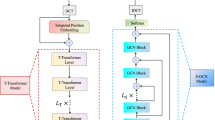Abstract
The spatio-temporal convolution model is widely recognized for its effectiveness in predicting action in various fields. This model typically uses video clips as input and employs multiple clips for inference, ultimately deriving a video-level prediction through an aggregation function. However, the model will give a high confidence prediction result, regardless of whether the input clips have sufficient spatio-temporal information to indicate its class or not. The inaccurate high confidence prediction errors can subsequently affect the accuracy of the video-level results. Although the current approach to mitigating this problem involves increasing the number of clips used, it fails to address this problem from its root causes. To solve this issue, we propose a fine-tuning framework based on Fuzzy error loss, aimed at further refining the well-trained spatio-temporal convolution model that relies on dense sampling. By giving a low confidence prediction output for clips with insufficient spatio-temporal information, our framework strives to enhance the accuracy of video-level motion recognition. We conducted extensive experiments on two motion recognition datasets, namely UCF101 and Kinetics-Sounds, to evaluate the effectiveness of our proposed framework. The results indicate a significant improvement in motion recognition accuracy at the video level on both data sets.
Access this chapter
Tax calculation will be finalised at checkout
Purchases are for personal use only
Similar content being viewed by others
References
Tran, D., Bourdev, L., Fergus, R., Torresani, L., Paluri, M.: Learning spatiotemporal features with 3D convolutional networks. In: 2015 IEEE International Conference on Computer Vision (ICCV) (2015). https://doi.org/10.1109/iccv.2015.510
Hara, K., Kataoka, H., Satoh, Y.: Can spatiotemporal 3D CNNs retrace the history of 2D CNNs and imagenet? In: 2018 IEEE/CVF Conference on Computer Vision and Pattern Recognition (2018). https://doi.org/10.1109/cvpr.2018.00685
Tran, D., Wang, H., Torresani, L., Ray, J., LeCun, Y., Paluri, M.: A closer look at spatiotemporal convolutions for action recognition. In: 2018 IEEE/CVF Conference on Computer Vision and Pattern Recognition (2018). https://doi.org/10.1109/cvpr.2018.00675
Feichtenhofer, C., Fan, H., Malik, J., He, K.: Slowfast networks for video recognition. In: 2019 IEEE/CVF International Conference on Computer Vision (ICCV) (2019). https://doi.org/10.1109/iccv.2019.00630
Feichtenhofer, C.: X3D: expanding architectures for efficient video recognition. In: 2020 IEEE/CVF Conference on Computer Vision and Pattern Recognition (CVPR) (2020). https://doi.org/10.1109/cvpr42600.2020.00028
Jiang, Y., Gong, X., Wu, J., Shi, H., Yan, Z., Wang, Z.: Auto-X3D: ultra-efficient video understanding via finer-grained neural architecture search. In: 2022 IEEE/CVF Winter Conference on Applications of Computer Vision (WACV) (2022). https://doi.org/10.1109/wacv51458.2022.00241
Wang, J., et al.: Maximizing spatio-temporal entropy of deep 3D CNNs for efficient video recognition (2023)
Tan, Y., Hao, Y., Zhang, H., Wang, S., He, X.: Hierarchical hourglass convolutional network for efficient video classification (2022)
Chen, C.F.R., et al.: Deep analysis of CNN-based spatio-temporal representations for action recognition. In: 2021 IEEE/CVF Conference on Computer Vision and Pattern Recognition (CVPR) (2021). https://doi.org/10.1109/cvpr46437.2021.00610
Shalmani, S., Chiang, F., Zheng, R.: Efficient action recognition using confidence distillation (2021)
Carreira, J., Zisserman, A.: Quo vadis, action recognition? A new model and the kinetics dataset. In: 2017 IEEE Conference on Computer Vision and Pattern Recognition (CVPR) (2017). https://doi.org/10.1109/cvpr.2017.502
Xie, S., Sun, C., Huang, J., Tu, Z., Murphy, K.: Rethinking spatiotemporal feature learning for video understanding (2017)
Wang, X., Girshick, R., Gupta, A., He, K.: Non-local neural networks. In: 2018 IEEE/CVF Conference on Computer Vision and Pattern Recognition (2018). https://doi.org/10.1109/cvpr.2018.00813
Wang, L., et al.: Temporal segment networks: towards good practices for deep action recognition. In: Leibe, B., Matas, J., Sebe, N., Welling, M. (eds.) ECCV 2016. LNCS, vol. 9912, pp. 20–36. Springer, Cham (2016). https://doi.org/10.1007/978-3-319-46484-8_2
Wu, Z., Xiong, C., Ma, C.Y., Socher, R., Davis, L.S.: Adaframe: adaptive frame selection for fast video recognition. In: 2019 IEEE/CVF Conference on Computer Vision and Pattern Recognition (CVPR) (2019). https://doi.org/10.1109/cvpr.2019.00137
Alwassel, H., Caba Heilbron, F., Ghanem, B.: Action search: spotting actions in videos and its application to temporal action localization. In: Ferrari, V., Hebert, M., Sminchisescu, C., Weiss, Y. (eds.) ECCV 2018. LNCS, vol. 11213, pp. 253–269. Springer, Cham (2018). https://doi.org/10.1007/978-3-030-01240-3_16
Gao, R., Oh, T.H., Grauman, K., Torresani, L.: Listen to look: action recognition by previewing audio. In: 2020 IEEE/CVF Conference on Computer Vision and Pattern Recognition (CVPR) (2020). https://doi.org/10.1109/cvpr42600.2020.01047
Wang, Y., Chen, Z., Jiang, H., Song, S., Han, Y., Huang, G.: Adaptive focus for efficient video recognition. In: 2021 IEEE/CVF International Conference on Computer Vision (ICCV) (2021). https://doi.org/10.1109/iccv48922.2021.01594
Wu, W., He, D., Tan, X., Chen, S., Wen, S.: Multi-agent reinforcement learning based frame sampling for effective untrimmed video recognition. In: 2019 IEEE/CVF International Conference on Computer Vision (ICCV) (2019). https://doi.org/10.1109/iccv.2019.00632
Huang, H., Zhou, X., He, R.: Orthogonal transformer: an efficient vision transformer backbone with token orthogonalization (2022)
UCF101: a dataset of 101 human actions classes from videos in the wild
Arandjelovic, R., Zisserman, A.: Look, listen and learn. In: 2017 IEEE International Conference on Computer Vision (ICCV) (2017). https://doi.org/10.1109/iccv.2017.73
Paszke, A., et al.: Pytorch: an imperative style, high-performance deep learning library. In: Advances in Neural Information Processing Systems, vol. 32, pp. 8024–8035. Curran Associates, Inc. (2019). http://papers.neurips.cc/paper/9015-pytorch-an-imperative-style-high-performance-deep-learning-library.pdf
Fan, H., Li, Y., Xiong, B., Lo, W.Y., Feichtenhofer, C.: Pyslowfast (2020). https://github.com/facebookresearch/slowfast
Acknowledgement
This work was supported in part by the National Natural Science Foundation of China under Grant 62072048, and in part by Industry-University-Research Innovation Fund of Universities in China under Grant 2021ITA07005.
Author information
Authors and Affiliations
Corresponding author
Editor information
Editors and Affiliations
Rights and permissions
Copyright information
© 2024 The Author(s), under exclusive license to Springer Nature Singapore Pte Ltd.
About this paper
Cite this paper
Li, J., Yang, M., Liu, Y., Xi, G., Zhang, L., Tian, Y. (2024). A Fuzzy Error Based Fine-Tune Method for Spatio-Temporal Recognition Model. In: Liu, Q., et al. Pattern Recognition and Computer Vision. PRCV 2023. Lecture Notes in Computer Science, vol 14425. Springer, Singapore. https://doi.org/10.1007/978-981-99-8429-9_8
Download citation
DOI: https://doi.org/10.1007/978-981-99-8429-9_8
Published:
Publisher Name: Springer, Singapore
Print ISBN: 978-981-99-8428-2
Online ISBN: 978-981-99-8429-9
eBook Packages: Computer ScienceComputer Science (R0)




